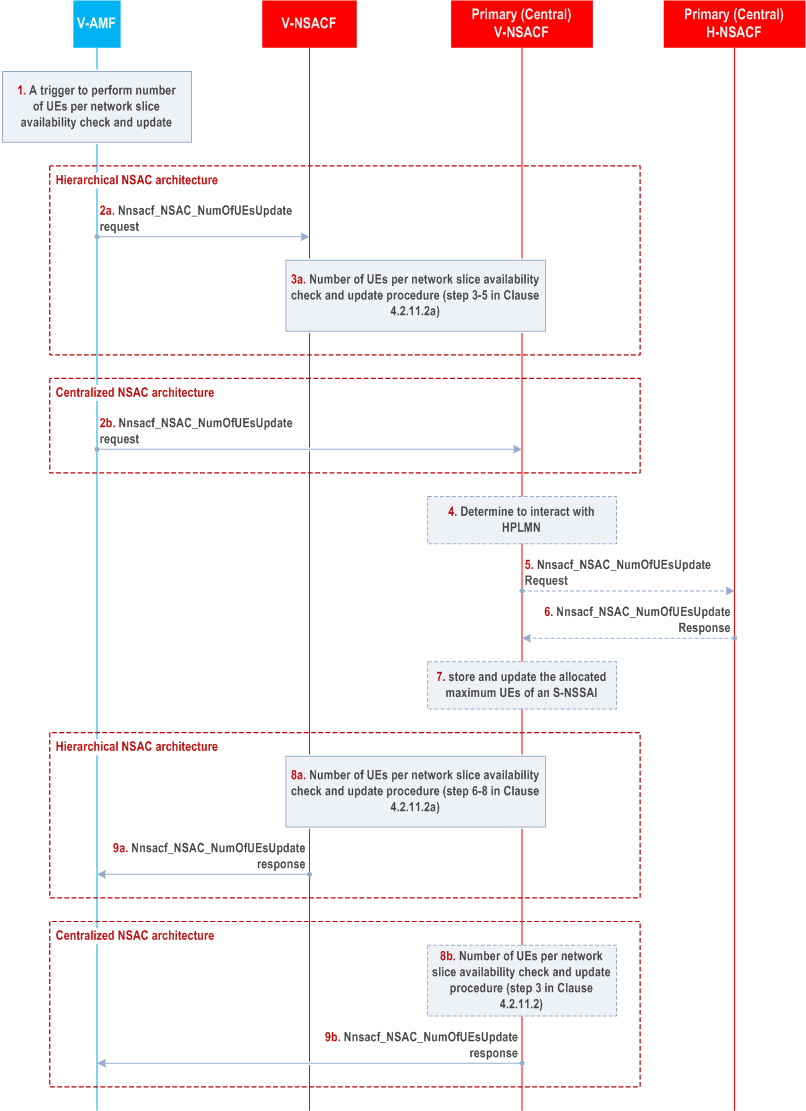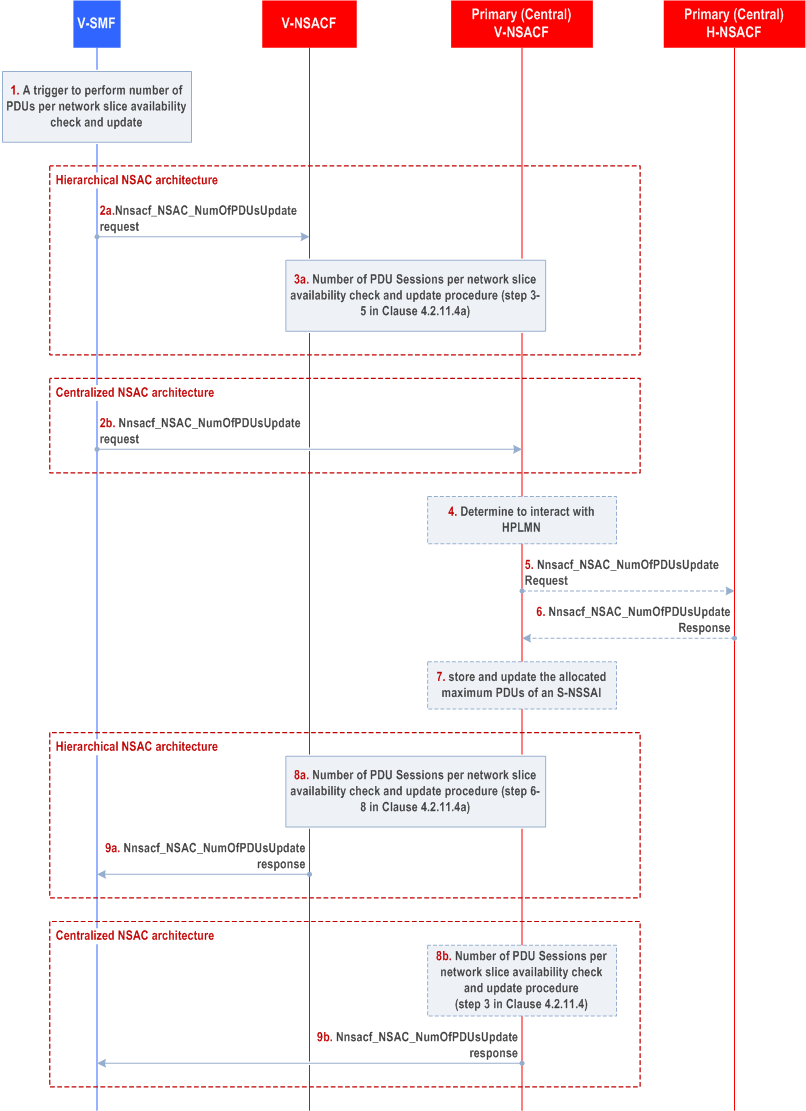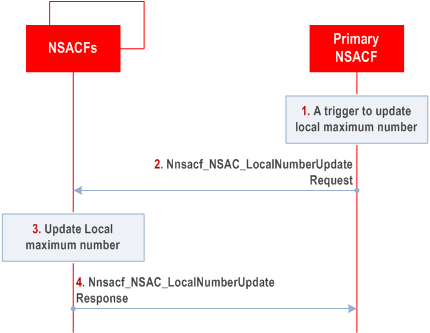Content for TS 23.502 Word version: 19.2.0
1…
4.2.2.2.2
4.2.2.2.3…
4.2.2.3…
4.2.3…
4.2.3.3
4.2.4…
4.2.6
4.2.7…
4.2.9…
4.2.11…
4.2.11.5…
4.3…
4.3.2.2.2
4.3.2.2.3…
4.3.3…
4.3.3.3
4.3.4…
4.3.4.3
4.3.5…
4.3.5.2…
4.3.5.4…
4.3.5.6…
4.3.6…
4.4…
4.5…
4.9…
4.9.1.3…
4.9.2…
4.11…
4.11.1…
4.11.1.2.2
4.11.1.2.3
4.11.1.3…
4.11.1.3.3…
4.11.1.4…
4.11.1.5…
4.11.2…
4.11.3…
4.12…
4.12.6…
4.12a…
4.12b…
4.13…
4.13.4…
4.13.6…
4.14…
4.15…
4.15.3.2.5…
4.15.4…
4.15.6…
4.15.6.7…
4.15.6.13…
4.15.6.14…
4.15.9…
4.15.9.4…
4.15.13…
4.15.13.4…
4.16…
4.16.4…
4.16.8…
4.16.11…
4.16.14…
4.16.15…
4.17…
4.17.9…
4.18…
4.19…
4.22…
4.23…
4.23.7…
4.23.7.3.3
4.23.7.3.4…
4.23.9…
4.23.9.4…
4.23.11…
4.24…
4.25…
4.25.6…
4.26…
5…
5.2.3…
5.2.5…
5.2.6…
5.2.7…
5.2.8…
5.2.9…
5.2.12…
5.2.18…
A…
E…
F…
G
H…
4.2.11.5 Network Slice Admission Control Support for Roaming
4.2.11.5.1 Network Slice Admission Control Support for Roaming by VPLMN
4.2.11.5.2 Network Slice Admission Control Support for Roaming by HPLMN
4.2.11.5.2.1 General
4.2.11.5.2.2 VPLMN with HPLMN assistance NSAC admission mode
4.2.11.5.2.3 VPLMN with HPLMN assistance NSAC Admission mode for number of Registered UEs
4.2.11.5.2.4 VPLMN with HPLMN assistance NSAC Admission mode for number of LBO PDU Sessions
4.2.11.5.2.5 HPLMN NSAC Admission
4.2.11.6 Update of local maximum number in Hierarchical NSAC Architecture
...
...
4.2.11.5 Network Slice Admission Control Support for Roaming p. 120
4.2.11.5.1 Network Slice Admission Control Support for Roaming by VPLMN p. 120
This clause describes the case of VPLMN NSAC admission mode.
For NSAC for roaming UEs, a maximum number of allowed UEs per mapped S-NSSAI in HPLMN and/or a maximum number of allowed PDU Sessions in LBO mode per mapped S-NSSAI in HPLMN is allocated to the VPLMN for each S-NSSAI in HPLMN and stored in one NSCAF in the VPLMN responsible for NSAC for the S-NSSAI in the HPLMN, subject to NSAC.
Enforcement for the maximum number of UEs registered with a network slice is done in the VPLMN by the NSACF in the VPLMN as per the description in Figure 4.2.11.2-1 with the following differences:
-
Step 2, in the Nnsacf_
NSAC_ service operation where the AMF provides both the S-NSSAI in VPLMN and the corresponding mapped S-NSSAI in HPLMN to the NSACF in the VPLMN.NumOfUEsUpdate_ Request - Step 3, the NSACF in the VPLMN performs NSAC for both the S-NSSAI in VPLMN and the corresponding mapped S-NSSAI in HPLMN based on the SLA between VPLMN and HPLMN.
-
Step 2, in the Nnsacf_
NSAC_ service operation where the V-SMF provides both the S-NSSAI in VPLMN and the corresponding mapped S-NSSAI in HPLMN to the NSACF in the VPLMN.NumOfPDUsUpdate_ Request - Step 3, the NSACF in the VPLMN performs NSAC for both the S-NSSAI in VPLMN and the corresponding mapped S-NSSAI in HPLMN based on the SLA between VPLMN and HPLMN.
-
For a centralized NSAC architecture in the VPLMN, the NSACF, being a centralized NSACF, issues the Nnsacf_
NSAC_ Request to fetch from the HPLMN centralized NSACF or primary NSACF the maximum number of registered UEs and the maximum number of LBO PDU sessions to be enforced.QuotaUpdate -
For a hierarchical NSAC architecture in the VPLMN, the NSACF issues the Nnsacf_
NSAC_ or Nnsacf_NumOfUEsUpdate_ Request NSAC_ to the VPLMN primary NSACF for NSAC for the maximum number of registered UEs, or NSAC for the maximum number of LBO PDU sessions. The VPLMN primary NSACF in turn issues the Nnsacf_NumOfPDUsUpdate_ Request NSAC_ Request, to fetch from the HPLMN centralized NSACF or primary NSACF the maximum number of registered UEs, or the maximum number of LBO PDU sessions to be admitted; this information in turn may be distributed to the VPLMN NSACF.QuotaUpdate
4.2.11.5.2 Network Slice Admission Control Support for Roaming by HPLMN p. 121
4.2.11.5.2.1 General p. 121
For maximum number of UEs in roaming case, there are two types of NSAC admission modes requiring interaction with HPLMN for inbound roamers; VPLMN with HPLMN assistance NSAC admission mode or HPLMN NSAC admission mode.
For PDU sessions in the home-routed roaming case, the SMF in HPLMN performs NSAC for the S-NSSAI(s) subject to NSAC.
For LBO PDU sessions, there are two types of NSAC admission mode requiring interaction with HPLMN for LBO PDU sessions; VPLMN with HPLMN assistance NSAC admission mode or HPLMN NSAC admission mode.
4.2.11.5.2.2 VPLMN with HPLMN assistance NSAC admission mode p. 121
For inbound roamers, depending on the NSAC architecture deployed in the VPLMN, enforcement for the maximum number of registered UEs with an S-NSSAI is done in the VPLMN by an NSACF in the VPLMN per the procedure described in clause 4.2.11.2 or clause 4.2.11.2a with the following differences:
- The AMF verifies the applicable NSAC admission mode for the inbound roamer based on the subscription data from UDM.
-
When the AMF invokes the Nnsacf_
NSAC_ service operation with the NSACF in the VPLMN, the AMF provides in the Request the additional NSAC admission mode parameter, i.e. VPLMN with HPLMN assistance NSAC admission mode.NumOfUEsUpdate_ Request -
If the maximum number of UEs is not available or the maximum number of UEs has been reached at the Primary (or Central) NSACF of the VPLMN and the type of NSAC admission mode is VPLMN with HPLMN assistance NSAC admission mode, the following is performed:
-
The Primary (or Central) NSACF in the VPLMN invokes Nnsacf_
NSAC_ to the Primary (or central) NSACF in the HPLMN for NSAC delegation and to receive an initial or a new allocated maximum number of UEs for the mapped S-NSSAI in HPLMN for inbound roamers. The request includes mapped S-NSSAI in HPLMN, PLMN ID and NSAC admission mode.NumOfUEsUpdate_ Request -
The Primary (or central) NSACF in HPLMN provides Nnsacf_
NSAC_ message to the Primary (or Central) NSACF of VPLMN. The response message includes mapped S-NSSAI in HPLMN, the new allocated maximum number of UEs for the mapped S-NSSAI in HPLMN for inbound roamers. Alternatively, the Primary (or central) NSACF rejects the request for the NSAC delegation.NumOfUEsUpdate_ Response - The Primary (or central) NSACF in VPLMN updates the previous stored maximum number of UEs based on the new received allocated maximum UEs number.
-
The Primary (or Central) NSACF in the VPLMN invokes Nnsacf_
-
At any time, the Primary (or central) NSACF in HPLMN may trigger Nnsacf_
NSAC_ Request message to the Primary (or central) NSAC in VPLMN to provide an updated maximum number of registered UEs for the mapped S-NSSAI in HPLMN for inbound roamers. Based on the updated maximum UEs number of the S-NSSAI, where applicable, the Primary NSACF in VPLMN may further perform distribution of local maximum UEs number to the NSACFs it interacts with. For more detail refer to clause 4.2.11.6.LocalNumberUpdate
- The SMF verifies the applicable NSAC admission mode for the S-NSSAI PDU session associated with the inbound roamer based on the subscription data from UDM.
-
When the SMF invokes the Nnsacf_
NSAC_ service operation to the NSACF in the VPLMN, the SMF provides in the Request the additional NSAC admission mode parameter, i.e. VPLMN with HPLMN assistance NSAC admission mode.NumOfPDUsUpdate_ Request -
If the maximum number of PDU Session is not available or the maximum number of PDU Sessions has been reached at the Primary (or Central) NSACF of the VPLMN and the type of NSAC admission mode is VPLMN with HPLMN assistance NSAC admission mode, the following is performed:
-
The Primary (or Central) NSACF in the VPLMN invokes Nnsacf_
NSAC_ to the Primary (or central) NSACF in the HPLMN for the NSAC delegation and to receive an initial or a new allocated maximum number of LBO PDU Sessions for the mapped S-NSSAI in HPLMN for inbound roamers. The request includes mapped S-NSSAI in HPLMN, PLMN ID and NSAC admission mode.NumOfPDUsUpdate_ Request -
The Primary (or central) NSACF in HPLMN provides the Nnsacf_
NSAC_ message to the Primary NSACF of VPLMN. The response message includes mapped S-NSSAI in HPLMN, the allocated maximum number of LBO PDU Sessions for the mapped S-NSSAI in HPLMN for inbound roamers. Alternatively, the Primary (or central) NSACF rejects the request for the NSAC delegation.NumOfPDUsUpdate_ Response - The Primary (or central) NSACF in VPLMN updates the previous stored maximum number of PDU Sessions based on the new received allocated maximum number of LBO PDU Sessions.
-
The Primary (or Central) NSACF in the VPLMN invokes Nnsacf_
-
At any time, the Primary (or central) NSACF in HPLMN may trigger Nnsacf_
NSAC_ Request message to the Primary (or central) NSAC in VPLMN to provide an updated new allocated maximum number of LBO PDU Sessions for the mapped S-NSSAI in HPLMN for the roaming UEs. Based on the updated maximum number of LBO PDU Sessions number of the S-NSSAI, where applicable, the Primary NSACF in VPLMN may further perform distribution of local maximum PDU Sessions number to the NSACFs it contacts. For more detail refer to clause 4.2.11.6.LocalNumberUpdate
4.2.11.5.2.3 VPLMN with HPLMN assistance NSAC Admission mode for number of Registered UEs p. 123

The procedure of NSAC for maximum number of UEs for a roaming UE registration is performed as follows:
Step 1.
If the Hierarchical NSAC architecture is deployed in the VPLMN, steps 2a-3a are executed and step 2b is skipped.
Same as step 1 defined in clause 4.2.11.2. For the inbound roaming UE, the AMF checks the NSAC admission mode of the registered S-NSSAI based on the subscription data from UDM.
Step 2a.
If the centralized NSAC architecture is deployed in the VPLMN, step 2b is executed and steps 2a-3a are skipped.
The AMF invokes Nnsacf_NSAC_NumOfUEsUpdate request to the NSACF in VPLMN same as step 2 of clause 4.2.11.2a with the additional parameter NSAC admission mode, i.e. VPLMN with HPLMN assistance NSAC admission mode.
Step 3a.
Same procedure of steps 3-5 in clause 4.2.11.2a is executed.
Step 2b.
If the Hierarchical NSAC architecture is deployed in the VPLMN, steps 8a-9a are executed and steps 8b-9b are skipped.
The AMF invokes Nnsacf_NSAC_NumOfUEsUpdate request to the central NSACF in VPLMN same as step 2 of clause 4.2.11.2 with the additional parameter NSAC admission mode, i.e. VPLMN with HPLMN assistance NSAC admission mode.
Step 4.
If there is no allocated maximum number of UEs from HPLMN or the allocated maximum number of registered UEs has been reached and the type of NSAC admission mode is VPLMN with HPLMN assistance NSAC admission mode, the Primary (or central) NSACF in VPLMN interacts with HPLMN. In this case, steps 5-7 are executed. Otherwise, steps 5-7 are skipped.
The Primary (or central) NSACF in VPLMN discovers the Primary (or central) NSACF in HPLMN.
Step 5.
The Primary (or central) NSACF in the VPLMN invokes Nnsacf_NSAC_NumOfUEsUpdate Request to the Primary (or central) NSACF in the HPLMN for NSAC delegation and to receive an initial or an updated maximum number of registered UEs for the mapped S-NSSAI in HPLMN for the inbound roamers. The request includes mapped S-NSSAI in HPLMN, PLMN ID and NSAC admission mode.
Step 6.
The Primary (or central) NSACF in HPLMN invokes Nnsacf_NSAC_NumOfUEsUpdate Response message to the Primary (or central) NSACF of VPLMN. The response message includes mapped S-NSSAI in HPLMN, the allocated maximum number of registered UEs for the mapped S-NSSAI in HPLMN for inbound roamers. Alternatively, the Primary (or central) NSACF in HPLMN rejects the request for the NSAC delegation.
Step 7.
The Primary (or central) NSACF in VPLMN updates the previous stored maximum number of UE based on the received allocated maximum number of UEs.
Step 8a.
If the centralized NSAC architecture is deployed in the VPLMN, steps 8b-9b are executed and steps 8a-9a are skipped.
This step is executed only if the NSACF in VPLMN has interacted with Primary NSACF in VPLMN at step 3a before. The NSACF with the assistance of Primary NSACF in VPLMN perform NSAC according to the steps 6-8 in clause 4.2.11.2a.
Step 9a.
Based on the response from Primary NSACF in VPLMN, the NSACF in VPLMN returns the response (i.e. acceptance or rejection) message to the AMF. The AMF provides the corresponding response to the inbound roaming UE.
Step 8b.
Same as the step 3 in clause 4.2.11.2 with the replacement of NSACF with Central NSACF.
Step 9b.
The Central NSACF in VPLMN returns the response (i.e. acceptance or rejection) message to the AMF. The AMF provides the corresponding response to the inbound roaming UE.
4.2.11.5.2.4 VPLMN with HPLMN assistance NSAC Admission mode for number of LBO PDU Sessions p. 125

The NSAC procedure for maximum number of LBO PDU Sessions for inbound roamers, is performed as follow:
Step 1.
If the Hierarchical NSAC architecture is deployed in the VPLMN, steps 2a-3a are executed and step 2b is skipped.
Same as steps 1 defined in clause 4.2.11.4. For the inbound roaming UE, the SMF checks the NSAC admission mode of the S-NSSAI for the LBO PDU session based on the subscription data from UDM.
Step 2a.
If the centralized NSAC architecture is deployed in the VPLMN, step 2b is executed and steps 2a-3a are skipped.
The SMF invokes Nnsacf_NSAC_NumOfsPDUsUpdate request to the NSACF in VPLMN same as step 2 of clause 4.2.11.4 with the additional parameter NSAC admission mode, i.e. VPLMN with HPLMN assistance NSAC admission mode.
Step 3a.
Same procedure of steps 3-5 in clause 4.2.11.4a is executed.
Step 2b.
If the Hierarchical NSAC architecture is deployed in the VPLMN, steps 8a-9a are executed and steps 8b are skipped.
The SMF invokes Nnsacf_NSAC_NumOfsPDUsUpdate request to the central NSACF in VPLMN same as step 2 of clause 4.2.11.4 with the additional parameter NSAC admission mode, i.e. VPLMN with HPLMN assistance NSAC admission mode.
Step 4-7.
The same procedure as step 4-7 of Figure 4.2.11.5.2.3-1 is applied with the difference that the maximum number of registered UE parameter is replaced with the maximum number of LBO PDU Sessions number. Nnsacf_NSAC_NumOfUEsUpdate service operation is replaced with Nnsacf_NSAC_NumOfPDUsUpdate service operation.
Step 8a.
If the centralized NSAC architecture is deployed in the VPLMN, steps 8b-9b are executed and steps 8a-9a are skipped.
This step is executed only if the NSACF in VPLMN has interacted with Primary NSACF in VPLMN at step 3a before. The NSACF with the assistance of Primary NSACF in VPLMN performs NSAC according to the steps 6-8 in clause 4.2.11.4a.
Step 9a.
Based on the response from Primary NSACF in VPLMN, the NSACF in VPLMN returns the response (i.e. acceptance or rejection) message to the SMF. The SMF provides the corresponding response to the inbound roaming UE.
Step 8b.
Same as the step 3 in clause 4.2.11.4 with the replacement of NSACF with Central NSACF.
Step 9b.
The Central NSACF in VPLMN returns the response (i.e. acceptance or rejection) message to the SMF. The SMF provides the corresponding response to the inbound roaming UE.
4.2.11.5.2.5 HPLMN NSAC Admission p. 126
Monitoring and enforcement for the maximum number of UEs registered with a network slice monitoring is done by the NSACF in the HPLMN per the procedure described in clause 4.2.11.2 with the following differences:
- Step 1, the AMF verifies the applicable NSAC admission mode for the registered S-NSSAI for the UE based on the subscription data from UDM. The S-NSSAI is the mapped S-NSSAI in HPLMN.
-
Step 2, in the Nnsacf_
NSAC_ service operation the V-AMF provides both the S-NSSAI in VPLMN and the corresponding mapped S-NSSAI in HPLMN to the NSACF in the HPLMN.NumOfUEsUpdate_ Request - Step 3, the NSCAF in the HPLMN performs NSAC for the corresponding mapped S-NSSAI in HPLMN.
- Step 1, the SMF verifies the applicable NSAC admission mode for the S-NSSAI used for the established PDU session based on the subscription data from UDM. The S-NSSAI is the mapped S-NSSAI in HPLMN.
-
Step 2, in the Nnsacf_
NSAC_ service operation the V-SMF provides both the S-NSSAI in VPLMN and the corresponding mapped S-NSSAI in HPLMN to the NSACF in the VPLMN.NumOfPDUsUpdate_ Request - Step 3, the NSACF in the HPLMN performs NSAC for the corresponding mapped S-NSSAI in HPLMN.
4.2.11.6 Update of local maximum number in Hierarchical NSAC Architecture |R18| p. 126

At any time the Primary NSACF may update the allocated local Maximum number of UE and/or PDU sessions configured at the NSACFs as follow:
Step 1.
The Primary NSACF decides to update the local maximum number of UE or PDU session values at the NSACF(s), i.e. the configured value at NSACF(s) based on the current registered UE/PDU session number at NSACFs and based on operator policy.
Step 2.
The Primary NSACF invokes Nnsacf_NSAC_LocalNumberUpdate Request to the NSACF(s). The message includes the new configured value of local Maximum number of UE or PDU sessions.
Step 3.
The NSACF replaces the local maximum number with the received new local maximum number value.
Step 4.
The NSACF returns the Nnsacf_NSAC_LocalNumberUpdate Response to the Primary NSACF.